A Convict Love Token from the Third Fleet?
A convict love token purchased in England by an Australian collector was almost certainly commissioned by a prisoner on Australia’s Third Fleet, and while we cannot be sure, it was probably a painter and glazier named George Evans who gave it to his love shortly before his ship sailed from the Thames.
Gary L. Sturgess
3/23/20256 min read
Australian collector Peter Lane sent me photos of a love token from his collection, the reverse of which shows a well-dressed man in shackles speaking to a well-dressed woman. Above the woman are the letters ‘ANE’ and above the man, ‘GE’. Down the right-hand side and along the bottom is the date ‘22 February 1791’. Between the ‘17’ and the ‘91’ two hearts have been engraved with an arrow through them. The whole has been done by an amateur without the benefit of professional tools.
Lane acquired the medallion in England, which probably means that it was presented by the prisoner to his beloved: it was usual for such tokens to be given by the convict to the one staying at home shortly before being sent away. Most of the surviving examples of convict tokens use the cartwheel penny which was released in 1797, so if this is a NSW love token, it is a very early example.
The obverse shows a man playing a lyre whilst riding a stylized dolphin, with the words, ‘When this you see remember me’. This image is of Arion of Corinth, a figure from ancient Greek mythology who was said to have been captured by pirates and rescued by dolphins. It was also said that he invented dithyrambic poetry.
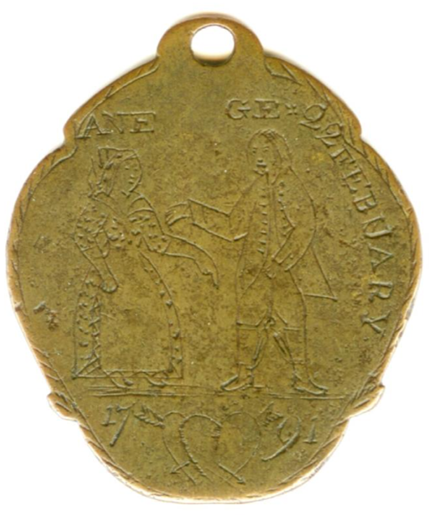

The medallion was a bronze season ticket for Vauxhall Gardens, a pleasure garden on the south bank of the river opposite Westminster which operated throughout the 18th century.

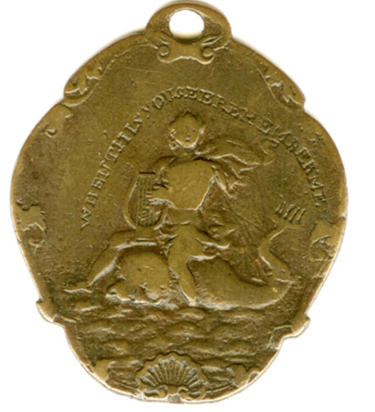
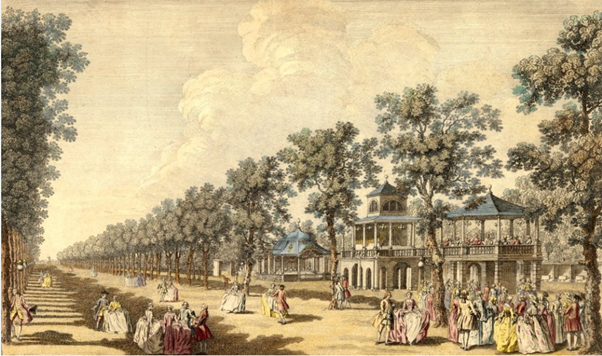

Vauxhall Gardens in the mid-18th century
A season ticket for the Vauxhall Gardens, British Museum
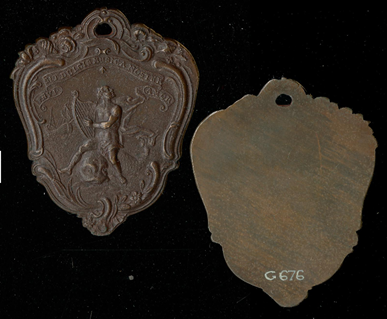

To prevent forgery, new tickets with a different design were issued each year: the version immediately below is similar to the token in Lane’s collection. It was issued in 1737 to Richard Arnold Esq., whose name and ticket number were inscribed on the back, and left with a child at the Foundling Hospital at some point in the 18th century as a means of later identification. The mother would have been unrelated to Mr Arnold, and the ticket would have been in general circulation
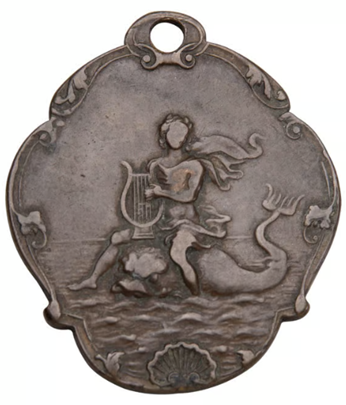

Vauxhall Garden ticket, 1737, Foundling Museum, London
The image of Arion escaping on the dolphin was used on a number of London theatre tickets around this time: the following is just one other example.
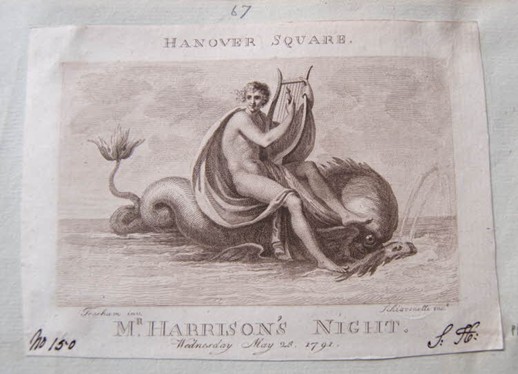

It is probable the Lane medallion was purchased by the prisoner for use as a love token and engraved by a fellow inmate with the limited tools at his disposal.
Identifying the Convict
The image on the reverse shows a rope or tape has been passed through the chain joining the shackles, and he appears to be holding the other end. Prisoners often tied such tapes around their waist, so they could walk without the chain dragging along the ground and tripping them.
There are several reasons for supposing that this token might have been the gift of a prisoner shipped to NSW in 1791. Such medallions were given when one of the lovers was going away for an extended period of time, and it is possible that this particular token was deliberately chosen because the giver was going over the ocean.
The date – 22 February 1791 – was a little more than a month before the Third Fleet sailed. The owner was possibly one of the 307 male convicts from Newgate who were sent on board the ships at Woolwich between the 24th and the 28th of February, or he might have been one of those shipped on board the Pitt in May of that year.
The engraved image on the Lane medallion shows a well-dressed couple, suggesting that they were not members of London’s criminal underclass, although it is possible that most of the engraving was already done when the prisoner purchased it, and the enterprising engraver simply added the initials and the date.
There were five male convicts with the initials ‘GE’ on the Third Fleet and the Pitt. Two were convicted in regional courts, and it is unlikely that they would have acquired an old bronze season ticket for the Vauxhall Gardens. [1]
Of the others, George Ellison was convicted of highway robbery at the Old Bailey in May 1787, and transported for life on the Albemarle, a Third Fleet ship. He died on the voyage. Ellison was 19 years old when convicted. His mother kept a public house, and he seems to have been an unemployed hairdresser who had worked for a gentleman at some point. He produced six character witnesses at his trial.
George Evans was a 26-year-old painter and glazier from High Holborn who was convicted at the Old Bailey in January 1789 of stealing two silk handkerchiefs from a shop where he was fitting a glass panel. To be transported for such a petty crime, it is likely that he had a prior criminal record. He signed his name with confidence, had sufficient capital or family support to employ counsel at his trial, and he paid to stay on the Master’s Side at Newgate prison. Evans was able to produce eight character witnesses at his trial. He was sent out on the Admiral Barrington, another Third Fleet ship.
There was another convict named George Evans, who was convicted at the Old Bailey in February 1791 and sent out on the Pitt. He was a young man living near Drury Lane and working as a porter and waterman in the Strand for the firm which operated the Hammersmith Coach. He was convicted of stealing a passenger’s trunk from the stage and sentenced to seven years transportation.
The two George Evans are not mentioned in the later convict musters, which indicates that they had either died or left the colony. Some information is available about them, but it is not possible to distinguish one from the other.
One of them was buried at Sydney in February 1797. The other sued two men in the Magistrates Court in September 1798 and was then sued by Jane Wood in the Civil Court the following May. A charge of theft was also brought against him in the Magistrates Court in May 1799, but the case was dismissed when the prosecutor failed to appear. George Evans sailed to India on the Minerva in February 1800 and his subsequent fate is unknown. (The surveyor and explorer of this name did not arrive in the colony until 1802.)
While we cannot be sure, I am inclined to the view that it was George Evans (per Barrington) who gave the love token to ANE, and left the colony on the Minerva in 1800, for the following reasons.
George Evans (Barrington) was a tradesman, who would have found well-paying work once he had finished his sentence in early 1796, if not before. By contrast, the man transported on the Pitt was a labourer, and his time did not expire until 1798 – it is unlikely that he would have been engaged in commercial transactions justifying civil court actions six months after his emancipation. Evans (Barrington) had either arrived with savings, or he had built up sufficient capital in the colony to pay for a passage home in 1800 – it is difficult to see that Evans (Pitt) could have done that.
My reasons for concluding that he is most likely the man who purchased the love token are much the same – Evans (Barrington) had a respectable trade and he was sufficiently well off to employ counsel at the Old Bailey and to stay on the Master’s Side. It seems more likely that such a man could afford to buy a bronze ticket and have it engraved, than Evans (Pitt). (I do not rule out the possibility that GE was George Ellison, although he was only 19 years old at the time of his conviction.)
____________
[1] I acknowledge my reliance on the Biographical Database of Australia in quickly identifying the five men with the initials GE on the Third Fleet and the Pitt, where they were convicted, and establishing the basic outlines of their lives.
Contact us
Connect with us
Botany Baymen acknowledges the traditional custodians of country throughout Australia and respects their connection to land, water and community.
© Botany Baymen 2024. All rights reserved.
You may download, display, print and reproduce this content for your personal or non-commercial use but only in an unaltered form and with the copyright acknowledged.

